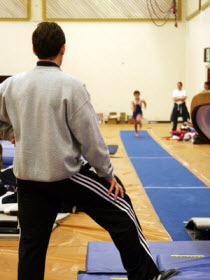The Vault is one of the 4 Olympic gymnastics events–along with Bars, Beam and Floor. Vault is an event that requires speed and strength.
The Apparatus
The apparatus itself was first called a “horse” or a “vaulting horse”. The apparatus has changed over the years and is now a table shape, called the “vault table”. The vault table is about 3.9 feet long and about 3.1 feet wide. The height is adjustable. To perform a vault, gymnasts run down the runway, jump onto a springboard, put their hands on the vault and then land on the other side of the vault table. Depending on what element the gymnast performs depends on how she gets from one side of the vault table to the other.
How Did My Daughter Who Didn’t Fall, Score Less Than one Who Did?
Any parent who has ever watched gymnastics on TV understands from the commentator that taking extra steps or falling on the vault landing is a deduction. But that’s just one thing the judges look for. Let’s look at some of the other dimensions.
In USA Gymnastics’ sanctioned meets, the gymnasts each perform two vaults. The vault with the better score counts. So if a gymnast performs one excellent vault and one poor vault, the excellent score will count. They are NOT averaged. That gymnast will end up with a better score than a gymnast who performed two good (but not excellent) vaults.
In AAU competitions (What is AAU gymnastics?), the gymnast will often only perform one vault, though a second vault can be performed.
 What Makes A Good Vault?
What Makes A Good Vault?
So what makes a good vault? Here are some things (though not all !) to watch for:
1) Good body position throughout the vault- Does the gymnast bend (pike) as they reach for the vault table, or show an arch in their back? Are their legs bent or separated? Do they bend their arms while on the vault? Ideally the gymnast shows a nice, tight body position with straight arms and legs, and toes pointed during the entire vault. There are four phases of the vault ( the first flight phase, the support/repulsion phase, the second flight phase and the landing) and the gymnast’s body position is evaluated in each of the three phases.
2) Exit off the Vault Table- When the gymnast comes off the vault, is there repulsion from the vault or do they look as if they are just falling off the vault table? Do they obtain good height ? Does it give you the impression of being a dynamic vault? There are deductions for height, distance traveled and the dynamics of a vault.

3) The Landing- On the landing, how much control (or lack there of ) is shown? The gymnast who has to move her arms and upper body along with taking a step to maintain balance will have a bigger deduction than one who merely takes a step. The gymnast who lands in a deep squat may receive up to a .3 deduction and if she also takes steps or moves her body, the deductions could be the same as a fall (.5 deduction).
A good vault only happens after a good run down the vault runway, so encourage your gymnast to run fast down the runway!